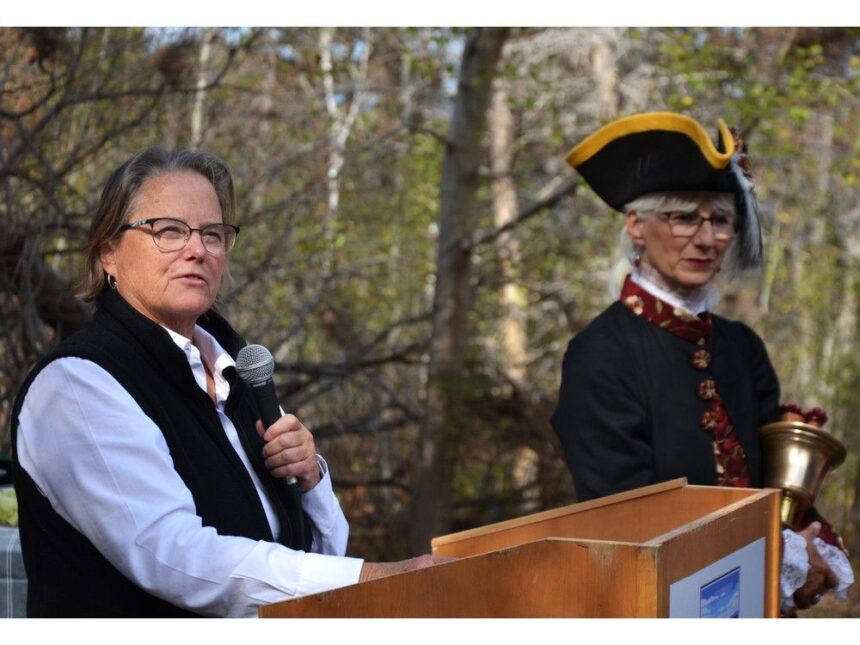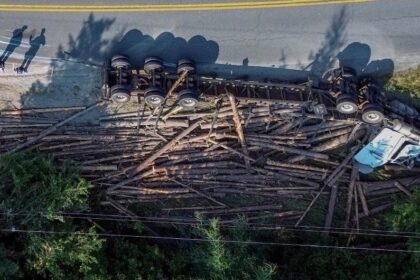Article contentArticle contentArticle contentArticle contentRyan said the amazing places program recognizes public locations of special significance that are recognized for their beauty, unique natural features, biodiversity, or cultural and historical aspects.Article content“Our site has many of these attributes,” she said proudly. “Located along the Bay of Fundy shore, the trails meander through forested ecosystems and then emerge along the coastal shoreline of the famous Bay of Fundy. The trail system includes two trails, Bohaker Trail and Charlie’s Trail.”Article content Debra Ryan, left, director of community development for the Municipality of the County of Annapolis, and Annapolis Royal town crier Christine Igot take part in a ceremony marking the 40th anniversary of the opening of the Delaps Cove Wilderness Trail Oct. 5. Photo by Lawrence Powell /Annapolis Valley RegisterArticle contentArticle contentThriving communityArticle contentThe area surrounding the trail system was once a thriving Black settlement with, at one time, close to 70 inhabitants. Census records show this community was in existence since at least 1838 but may date back much earlier.Article content“The Mi’kmaq name for the area was Medabankkeajtc,” said Ryan, noting it means little red bank. “In this region, Mi’kmaq and Black pioneers were integrated for several generations after the American Revolutionary War (1775-1783).”Article contentArticle contentLeBlanc said the municipality has worked with the Delaps Cove Black Indian Pioneer Society to share new insights into the historic significance of the lands at Delaps Cove and a municipal proclamation recognizes Black Mi’kmaq Day annually on June 1.Article contentDuston Stevenson, a councillor with the Delaps Cove Black Indian Pioneer Society, explained the history of Delaps Cove, where his ancestors lived, and his work with Annapolis County over the past 10 years, providing insight into historic and cultural truths.Article content Duston Stevenson, a councillor with the Delaps Cove Black Indian Pioneer Society, presents Deb Ryan, director of community development with the County of Annapolis, with a certificate of recognition. Photo by Lawrence Powell /Annapolis Valley RegisterArticle contentArticle contentSmudging ceremonyArticle contentErica Phillips initiated a smudging ceremony, helping the many participants waft the smoke. Stevenson explained the meaning behind the smudging ceremony, the types of grasses and woods used, and the meaning of the direction facing, the time of year, and the effects of the wafting smoke.Article content Duston Stevenson, a councillor with the Delaps Cove Black Indian Pioneer Society, explains smudging ceremonies during a gathering at the Delaps Cove Wilderness Trail Oct. 5. Delaps Cove is his ancestral land. Photo by Lawrence Powell /Annapolis Valley RegisterArticle contentThe gathering was held in the parking lot of the trail system due to temporary regulations prohibiting travel on the woods trails in Annapolis County due to the threat of wildfires.Article contentArticle contentLeBlanc noted that since the creation of the Delaps Cove trail, the municipal park system has grown to more than 20 parks and trails.Article content“The Delaps Cove trail system has been a popular destination for both residents and visitors to our county,” she said. “Visitors have had the opportunity to explore the famous Bay of Fundy shore, the forested ecosystems, and the history of the region.”Article contentShe also said the coastal properties at the Delaps Cove Wilderness Trail system are protected under a municipal policy that provides outdoor recreation, tourism, educational, and cultural opportunities while protecting biodiversity and natural features of the property now and into the future.Article content“These lands have been included as part of the Pathway to Canada Target 1 program, which is part of a national database for the protection and conservation of lands to meet Canada’s commitment of 17 per cent of terrestrial areas and inland waters,” she said. “We have invested and will continue to invest in the trail system into the future.”
Delaps Cove Wilderness Trail named UNESCO Amazing Place












